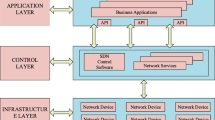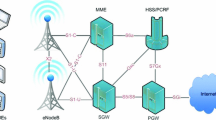Abstract
Spectrum efficiency is a constant challenge in the design of wireless networks. Space-division-multiple-access (SDMA) is a promising approach to achieve higher spectral efficiency which reuses bandwidth via multiplexing signals based on their spatial signature. Several different studies have shown that SDMA can effectively improve system capacity in a mobile environment. In this paper, we present a new Markov chain traffic model for a duplicate-at-last (DL) approach [IEE Proceedings on Communication 146 (1999) 303] in two-fold and three-fold SDMA systems. Simplified blocking probability formulations for two-fold and three-fold SDMA are also derived. Simulations based on a common method of spatial separation check for channel allocation in SDMA are presented to evaluate the probability of successfully creating two-fold and three-fold SDMA channels. The simulation, as well as analytical, results indicate that the SDMA system can reduce the blocking probability of the calls and result in more traffic loading than a traditional cellular system. The results also show that our simplified approaches not only can reduce the computational complexity, but can also accurate approximate two-fold and three-fold SDMA performance.
Similar content being viewed by others
References
G.M. Galvan-Tejada and J.G. Gardiner, “Theoretical Blocking Probability for SDMA”, IEE Proceedings on Communication, Vol. 146, pp. 303–306, 1999.
J. Fuhl, A. Kuchar and E. Bonek, “Capacity Increase in Cellular PCS by Smart Antennas”, IEEE VTC, Vol. 3, pp. 1962–1966, 1997.
E. Buracchini, F. Muratore, V. Palestini and M. Sinibaldi, “Performance Analysis of a Mobile System Based on combined SDMA/CDMA Access Technique”, IEEE Spread Spectrum Techniques and Applications Proceedings, Vol. 1, pp. 370–374, 1996.
C. Farsakh and J.A. Nossek, “On the Mobile Radio Capacity Increase Through SDMA”, IEEE International Zurich Seminar on Broadband Communications, pp. 293–297, 1998.
C. Farsakh and J.A. Nossek, “Channel Allocation and Downlink Beamforming in an SDMA Mobile Radio System”, IEEE PIMRC, Vol. 2, pp. 687–691, 1995.
C. Farsakh and J.A. Nossek, “A Real Time Downlink Channel Allocation Scheme for an SDMA Mobile Radio System”, IEEE PIMRC, Vol. 3, pp. 1216–1220, 1996.
G. Tsoulos, M. Beach and J. McGeehan, “Wireless Personal Communications for the 21th Century: European Technological Advances in Adaptive Antennas”, IEE Communication Magazine, Vol. 3, pp. 102– 109, 1997.
B. Ottersten, “Array Processing for Wireless Communication”, IEE SSAP, Vol. 1, pp. 466–473, 1996.
J.S. Lee and L.E. Miller, CDMA Systems Engineering Handbook, Artech House Publishers, 1998.
J.R. Norris, Markov Chains, Cambridge University Press, 1997.
F. Piolini and A. Rolando, “Smart Channel-Assignment Algorithm for SDMA Systems”, IEEE Transactions on Microwave Theory and Techniques, Vol. 47, pp. 693–699, 1999.
G.M. Galvan-Tejada and J.G. Gardiner, “Theoretical Model to Determine the Blocking Probability for SDMA Systems”, IEEE Transactions on Vechicular Technology, Vol. 50, pp. 1279–1288, 2001.
J. Eberspacher and H.-J. Vogel, “GSM: Switching, Service and Protocols”, John Wiley & Sons, 1998.
J. Razavilar, F. Rashid-Farrokhi and K.J. Ray Liu, “Traffic Improvements in Wireless Communication Networks Using Antenna Arrays”, IEEE Journal on Selected Areas in Communications, Vol. 18, No. 3, pp. 458–471, 2000.
W. Huang and J.F. Doherty, “An Improvement on Blocking Probability for SDMA”, IEEE Signal Proccessing Advances in Wireless Communications Proceedings, Vol. 1, pp. 26–29, 2001.
W. Huang and J.F. Doherty, “An Evaluation of Blocking Probability for Three-fold SDMA”, IEEE Military Communications Conference 2001 MILCOM2001, Vol. 2, pp. 1248–1252, 2001.
J.L. Barlow, “On the Smallest Positive Singular Value of a Singular M-Martix with Applications to Ergodic Markov Chains”, SIAM Journal of Algebraic Discrete Methods, Vol. 7, No. 3, pp. 414–424, 1986.
J.L. Barlow, “Error Bounds for the Computation of Null Vectors with Applications to Markov Chains”, SIAM Journal on Matrix Analysis and Applications, Vol. 14, No. 3, pp. 798–812, 1993.
C.D. Meyer Jr., “The Role of the Group Inverse in the Theory of Finite Markov Chains”, SIAM Review, Vol.~17, pp. 443–464, 1975.
M. Tangemann, “Near Far Effects in Adaptive SDMA Systems”, IEEE PIMRC, Vol. 3, pp. 1293–1297, 1995.
X. Fang, “More Realistic Analysis for Blocking Probability in SDMA Systems”, IEEE Proceedings in Communications, Vol. 149, No. 3, pp. 152–156, 2002.
X. Fang, “More Realistic Performance Analysis for SDMA Systems”, IEEE Vehicular Technology Conference, Vol. 3, pp. 1533–1537, 2001.
Author information
Authors and Affiliations
Corresponding author
Additional information
Wen-Jye Huang received the B.S. degree in electrical engineering from Tatung Institute of Technology, Taipei, Taiwan, in 1991, the M.S. degree in electrical engineering from Ohio University, Athens, OH, in 1997, and the Ph.D. degree in electrical engineering from The Pennsylvania State University, University Park, PA, in 2001.
Since 2002, he joined the Department of Electrical Engineering, Chang Gung University, Kwei-San, Tao-Yuan, Taiwan, as an assistant professor. His research activities include smart antenna, SDMA, and MC-CDMA techniques.
John F. Doherty received the B.S. degree (with honors) in engineering science from the College of Staten Island, City University of New York, in 1982, the M.Eng. degree in electrical engineering from Stevens Institute of Technology, Hoboken, NJ, in 1985, and the Ph.D. degree in electrical engineering from Rutgers University, New Brunswick, NJ, in 1990. He was an integrated circuit reliability engineer with IBM, from 1982 to 1984. From 1985 to 1988, he was member of the technical staff at AT&T Bell Laboratories, working in sonar signal processing.
In 1990, he joined the Electrical and Computer Engineering Department, Iowa State University, Ames, as an assistant professor and Harpole Entair fellow. He is currently an associate professor of electrical engineering with The Pennsylvania State University, University Park. His current research activities include interference rejection in wireless communication systems, spatial-division multiple-access techniques, and radar target detection techniques. He is a former AFOSR summer faculty research fellow at the Rome Laboratory, Rome, NY, and an Army Research Office Young Investigator.
Rights and permissions
About this article
Cite this article
Huang, WJ., Doherty, J.F. Traffic Models and Blocking Probabilities for Two-Fold and Three-Fold SDMA Communication Systems. Wireless Pers Commun 34, 279–305 (2005). https://doi.org/10.1007/s11277-005-4111-z
Issue Date:
DOI: https://doi.org/10.1007/s11277-005-4111-z




